A Report on Planning for Business Transformation: Risk & Compliance
VerifiedAdded on 2023/05/28
|14
|3356
|54
Report
AI Summary
This report provides a comprehensive analysis of risk and compliance requirements in the context of business transformation. It identifies and categorizes internal and external compliance risks, providing examples such as password protection, virus protection, Employment Relations Act 2000, and Income Tax Act 1983. The report emphasizes the importance of internal communication among stakeholders to ensure adherence to compliance requirements and mitigate potential risks. It outlines specific measures to be taken for virus protection, including installing antivirus programs, frequent system updates, and employee training. The roles and responsibilities of a dedicated team are highlighted, along with additional guidance for maintaining a secure and compliant business environment. The document concludes by underscoring the significance of proactive risk management and continuous communication in achieving successful business transformation.
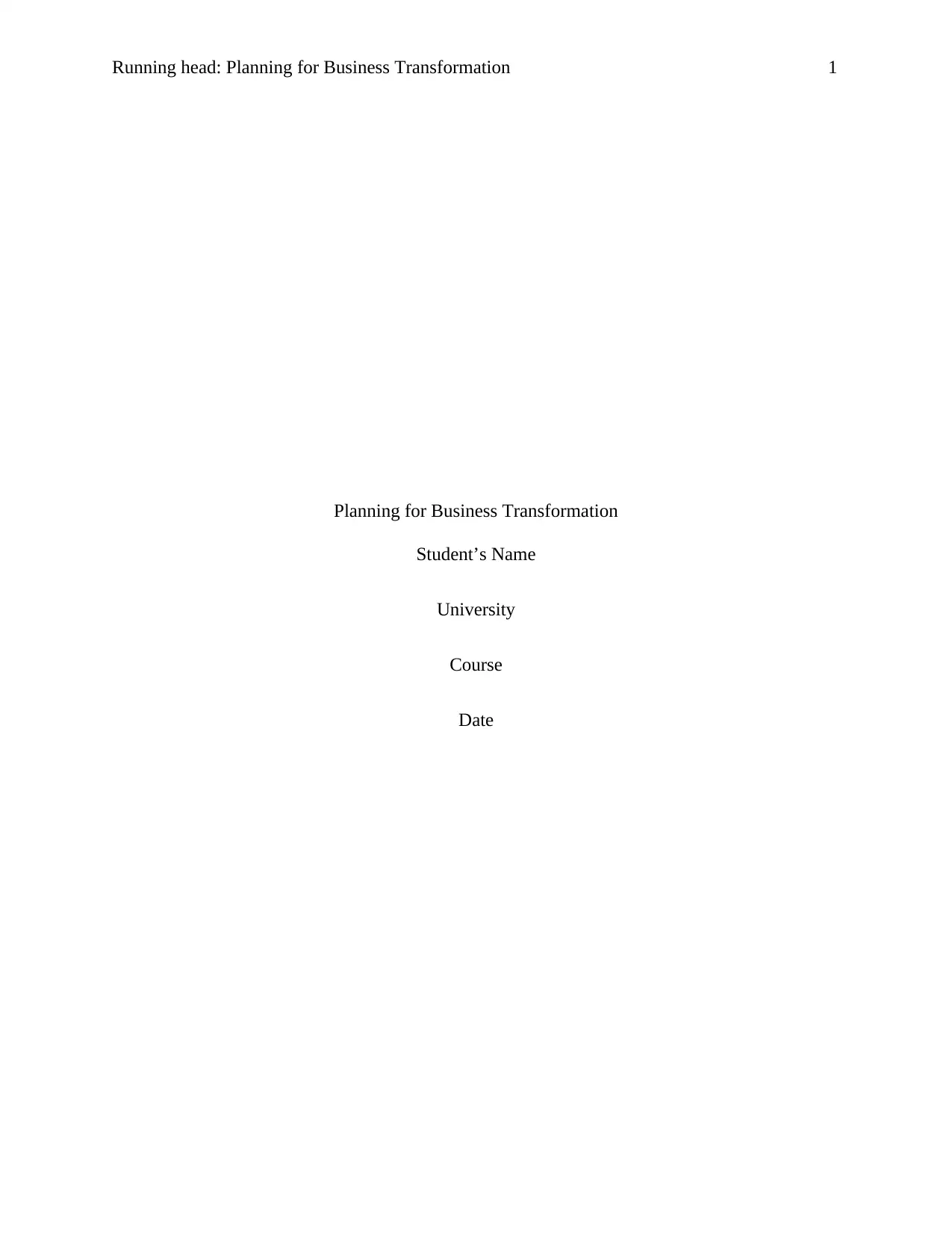
Running head: Planning for Business Transformation 1
Planning for Business Transformation
Student’s Name
University
Course
Date
Planning for Business Transformation
Student’s Name
University
Course
Date
Paraphrase This Document
Need a fresh take? Get an instant paraphrase of this document with our AI Paraphraser
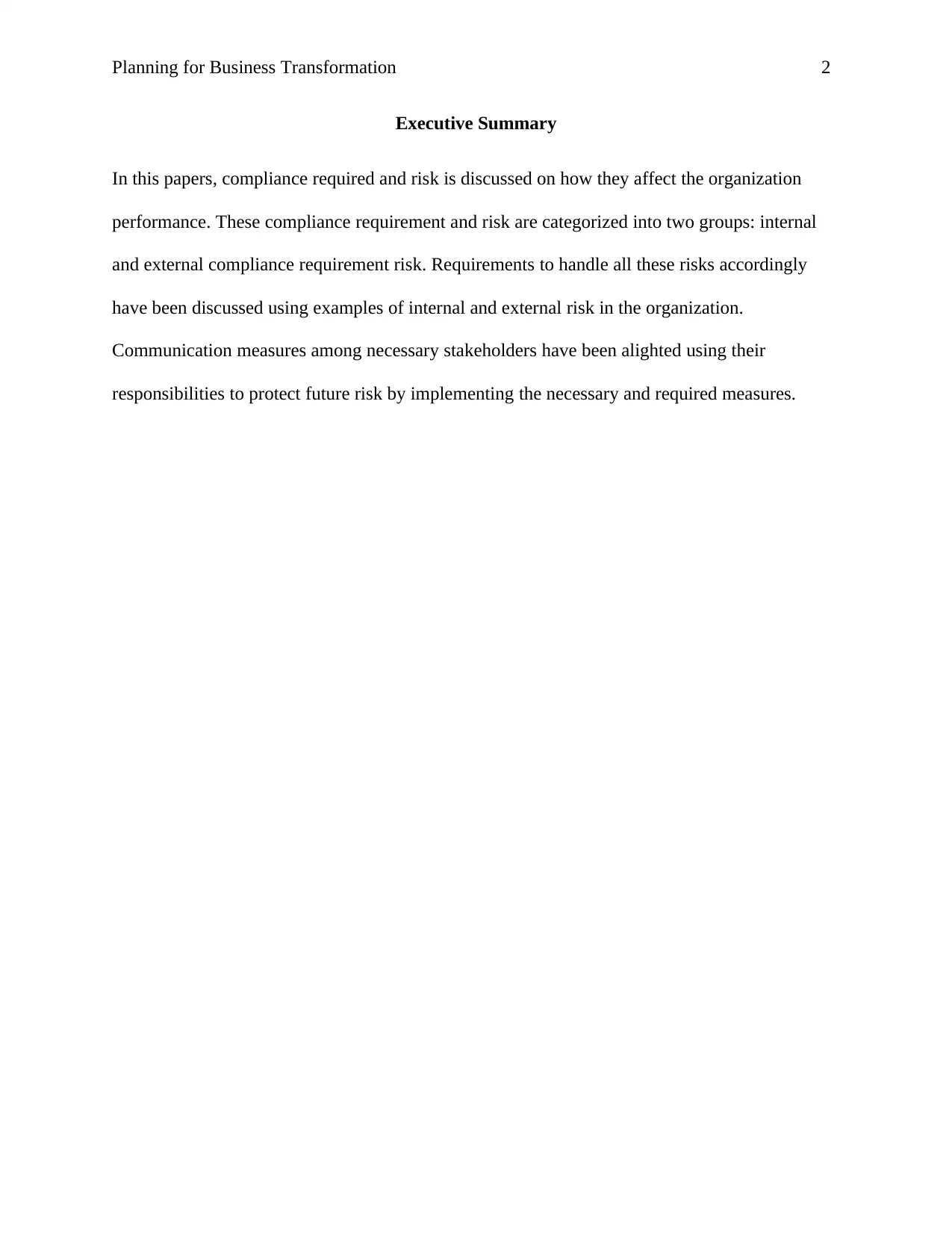
Planning for Business Transformation 2
Executive Summary
In this papers, compliance required and risk is discussed on how they affect the organization
performance. These compliance requirement and risk are categorized into two groups: internal
and external compliance requirement risk. Requirements to handle all these risks accordingly
have been discussed using examples of internal and external risk in the organization.
Communication measures among necessary stakeholders have been alighted using their
responsibilities to protect future risk by implementing the necessary and required measures.
Executive Summary
In this papers, compliance required and risk is discussed on how they affect the organization
performance. These compliance requirement and risk are categorized into two groups: internal
and external compliance requirement risk. Requirements to handle all these risks accordingly
have been discussed using examples of internal and external risk in the organization.
Communication measures among necessary stakeholders have been alighted using their
responsibilities to protect future risk by implementing the necessary and required measures.
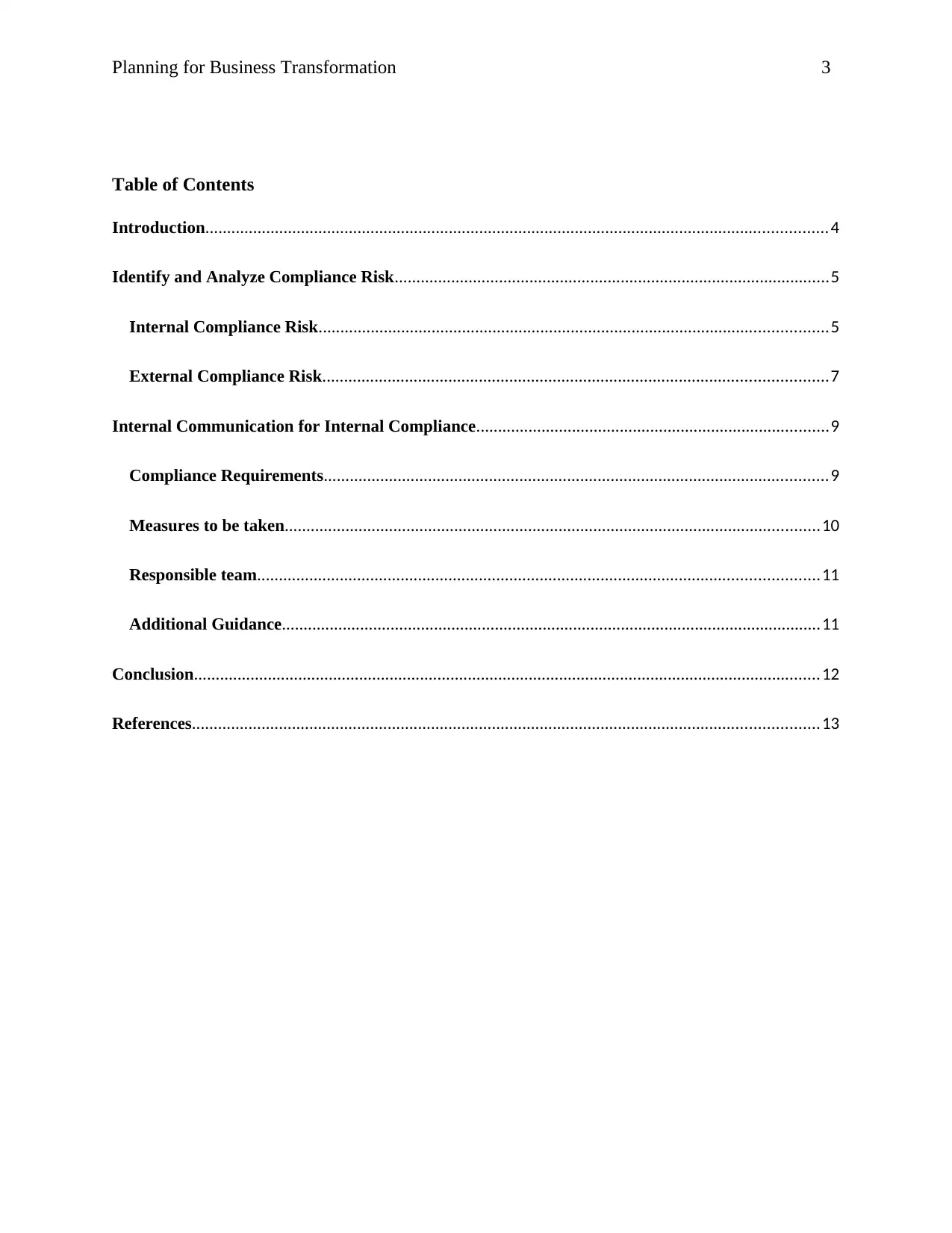
Planning for Business Transformation 3
Table of Contents
Introduction...............................................................................................................................................4
Identify and Analyze Compliance Risk....................................................................................................5
Internal Compliance Risk.....................................................................................................................5
External Compliance Risk....................................................................................................................7
Internal Communication for Internal Compliance.................................................................................9
Compliance Requirements....................................................................................................................9
Measures to be taken...........................................................................................................................10
Responsible team.................................................................................................................................11
Additional Guidance............................................................................................................................11
Conclusion................................................................................................................................................12
References................................................................................................................................................13
Table of Contents
Introduction...............................................................................................................................................4
Identify and Analyze Compliance Risk....................................................................................................5
Internal Compliance Risk.....................................................................................................................5
External Compliance Risk....................................................................................................................7
Internal Communication for Internal Compliance.................................................................................9
Compliance Requirements....................................................................................................................9
Measures to be taken...........................................................................................................................10
Responsible team.................................................................................................................................11
Additional Guidance............................................................................................................................11
Conclusion................................................................................................................................................12
References................................................................................................................................................13
⊘ This is a preview!⊘
Do you want full access?
Subscribe today to unlock all pages.

Trusted by 1+ million students worldwide
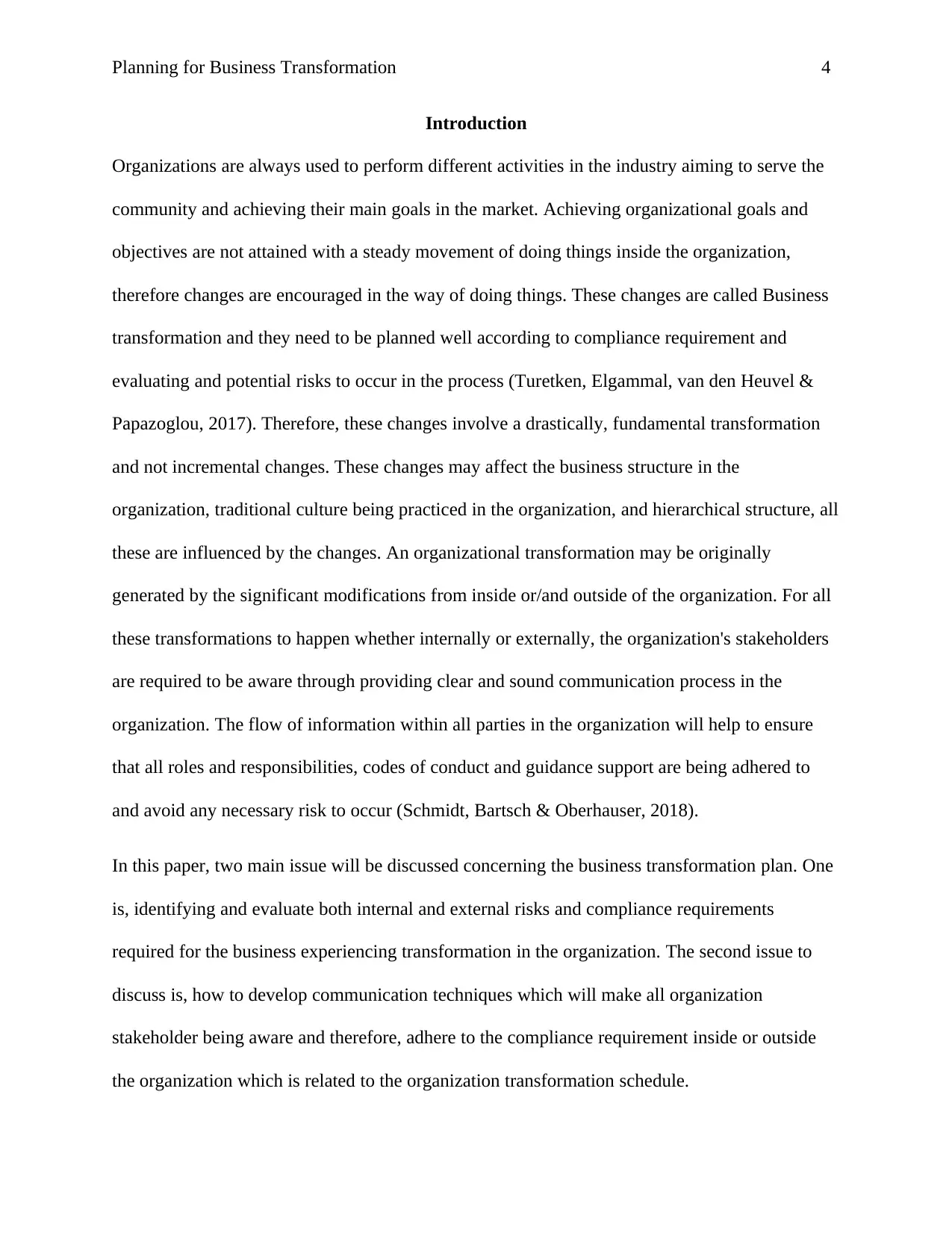
Planning for Business Transformation 4
Introduction
Organizations are always used to perform different activities in the industry aiming to serve the
community and achieving their main goals in the market. Achieving organizational goals and
objectives are not attained with a steady movement of doing things inside the organization,
therefore changes are encouraged in the way of doing things. These changes are called Business
transformation and they need to be planned well according to compliance requirement and
evaluating and potential risks to occur in the process (Turetken, Elgammal, van den Heuvel &
Papazoglou, 2017). Therefore, these changes involve a drastically, fundamental transformation
and not incremental changes. These changes may affect the business structure in the
organization, traditional culture being practiced in the organization, and hierarchical structure, all
these are influenced by the changes. An organizational transformation may be originally
generated by the significant modifications from inside or/and outside of the organization. For all
these transformations to happen whether internally or externally, the organization's stakeholders
are required to be aware through providing clear and sound communication process in the
organization. The flow of information within all parties in the organization will help to ensure
that all roles and responsibilities, codes of conduct and guidance support are being adhered to
and avoid any necessary risk to occur (Schmidt, Bartsch & Oberhauser, 2018).
In this paper, two main issue will be discussed concerning the business transformation plan. One
is, identifying and evaluate both internal and external risks and compliance requirements
required for the business experiencing transformation in the organization. The second issue to
discuss is, how to develop communication techniques which will make all organization
stakeholder being aware and therefore, adhere to the compliance requirement inside or outside
the organization which is related to the organization transformation schedule.
Introduction
Organizations are always used to perform different activities in the industry aiming to serve the
community and achieving their main goals in the market. Achieving organizational goals and
objectives are not attained with a steady movement of doing things inside the organization,
therefore changes are encouraged in the way of doing things. These changes are called Business
transformation and they need to be planned well according to compliance requirement and
evaluating and potential risks to occur in the process (Turetken, Elgammal, van den Heuvel &
Papazoglou, 2017). Therefore, these changes involve a drastically, fundamental transformation
and not incremental changes. These changes may affect the business structure in the
organization, traditional culture being practiced in the organization, and hierarchical structure, all
these are influenced by the changes. An organizational transformation may be originally
generated by the significant modifications from inside or/and outside of the organization. For all
these transformations to happen whether internally or externally, the organization's stakeholders
are required to be aware through providing clear and sound communication process in the
organization. The flow of information within all parties in the organization will help to ensure
that all roles and responsibilities, codes of conduct and guidance support are being adhered to
and avoid any necessary risk to occur (Schmidt, Bartsch & Oberhauser, 2018).
In this paper, two main issue will be discussed concerning the business transformation plan. One
is, identifying and evaluate both internal and external risks and compliance requirements
required for the business experiencing transformation in the organization. The second issue to
discuss is, how to develop communication techniques which will make all organization
stakeholder being aware and therefore, adhere to the compliance requirement inside or outside
the organization which is related to the organization transformation schedule.
Paraphrase This Document
Need a fresh take? Get an instant paraphrase of this document with our AI Paraphraser
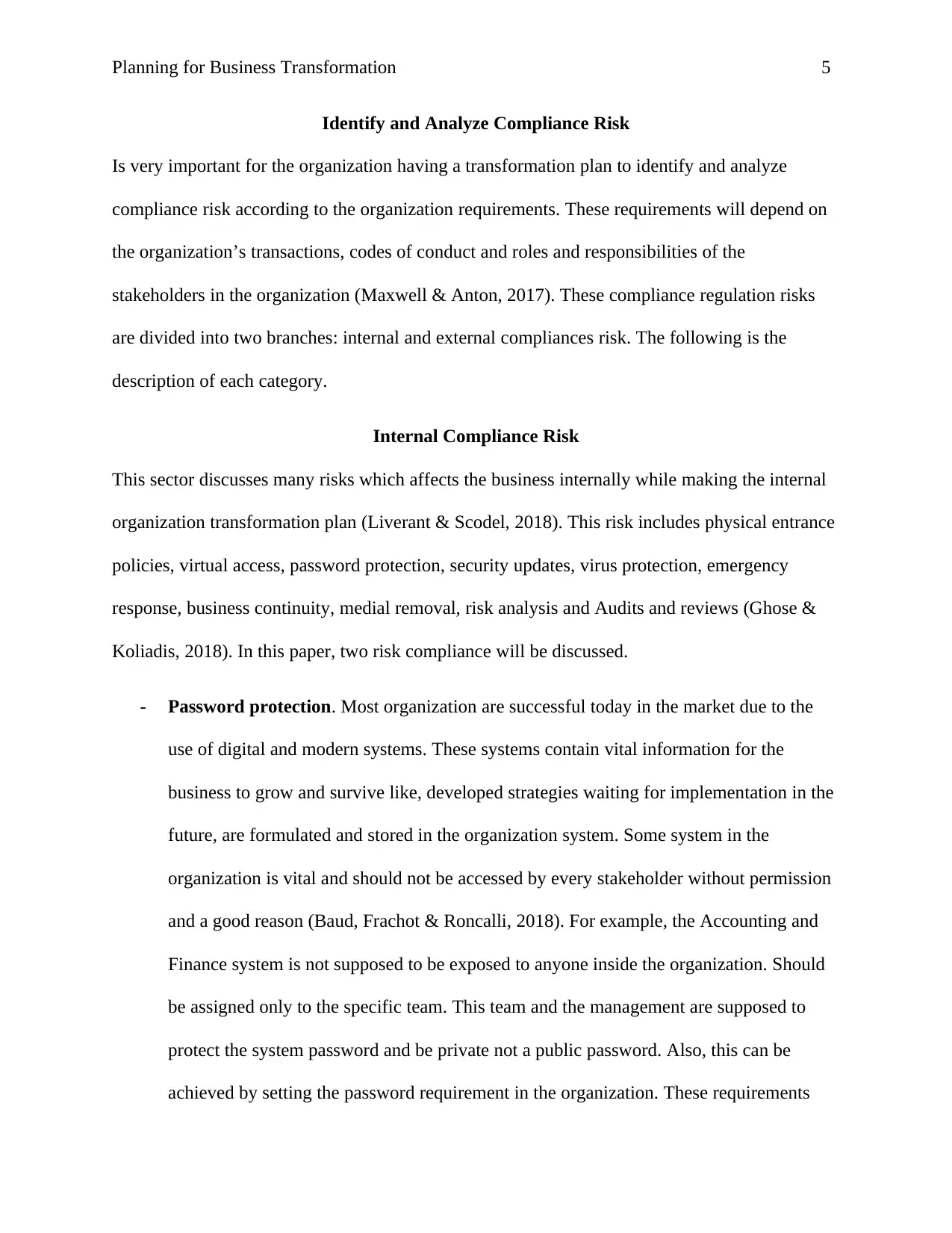
Planning for Business Transformation 5
Identify and Analyze Compliance Risk
Is very important for the organization having a transformation plan to identify and analyze
compliance risk according to the organization requirements. These requirements will depend on
the organization’s transactions, codes of conduct and roles and responsibilities of the
stakeholders in the organization (Maxwell & Anton, 2017). These compliance regulation risks
are divided into two branches: internal and external compliances risk. The following is the
description of each category.
Internal Compliance Risk
This sector discusses many risks which affects the business internally while making the internal
organization transformation plan (Liverant & Scodel, 2018). This risk includes physical entrance
policies, virtual access, password protection, security updates, virus protection, emergency
response, business continuity, medial removal, risk analysis and Audits and reviews (Ghose &
Koliadis, 2018). In this paper, two risk compliance will be discussed.
- Password protection. Most organization are successful today in the market due to the
use of digital and modern systems. These systems contain vital information for the
business to grow and survive like, developed strategies waiting for implementation in the
future, are formulated and stored in the organization system. Some system in the
organization is vital and should not be accessed by every stakeholder without permission
and a good reason (Baud, Frachot & Roncalli, 2018). For example, the Accounting and
Finance system is not supposed to be exposed to anyone inside the organization. Should
be assigned only to the specific team. This team and the management are supposed to
protect the system password and be private not a public password. Also, this can be
achieved by setting the password requirement in the organization. These requirements
Identify and Analyze Compliance Risk
Is very important for the organization having a transformation plan to identify and analyze
compliance risk according to the organization requirements. These requirements will depend on
the organization’s transactions, codes of conduct and roles and responsibilities of the
stakeholders in the organization (Maxwell & Anton, 2017). These compliance regulation risks
are divided into two branches: internal and external compliances risk. The following is the
description of each category.
Internal Compliance Risk
This sector discusses many risks which affects the business internally while making the internal
organization transformation plan (Liverant & Scodel, 2018). This risk includes physical entrance
policies, virtual access, password protection, security updates, virus protection, emergency
response, business continuity, medial removal, risk analysis and Audits and reviews (Ghose &
Koliadis, 2018). In this paper, two risk compliance will be discussed.
- Password protection. Most organization are successful today in the market due to the
use of digital and modern systems. These systems contain vital information for the
business to grow and survive like, developed strategies waiting for implementation in the
future, are formulated and stored in the organization system. Some system in the
organization is vital and should not be accessed by every stakeholder without permission
and a good reason (Baud, Frachot & Roncalli, 2018). For example, the Accounting and
Finance system is not supposed to be exposed to anyone inside the organization. Should
be assigned only to the specific team. This team and the management are supposed to
protect the system password and be private not a public password. Also, this can be
achieved by setting the password requirement in the organization. These requirements
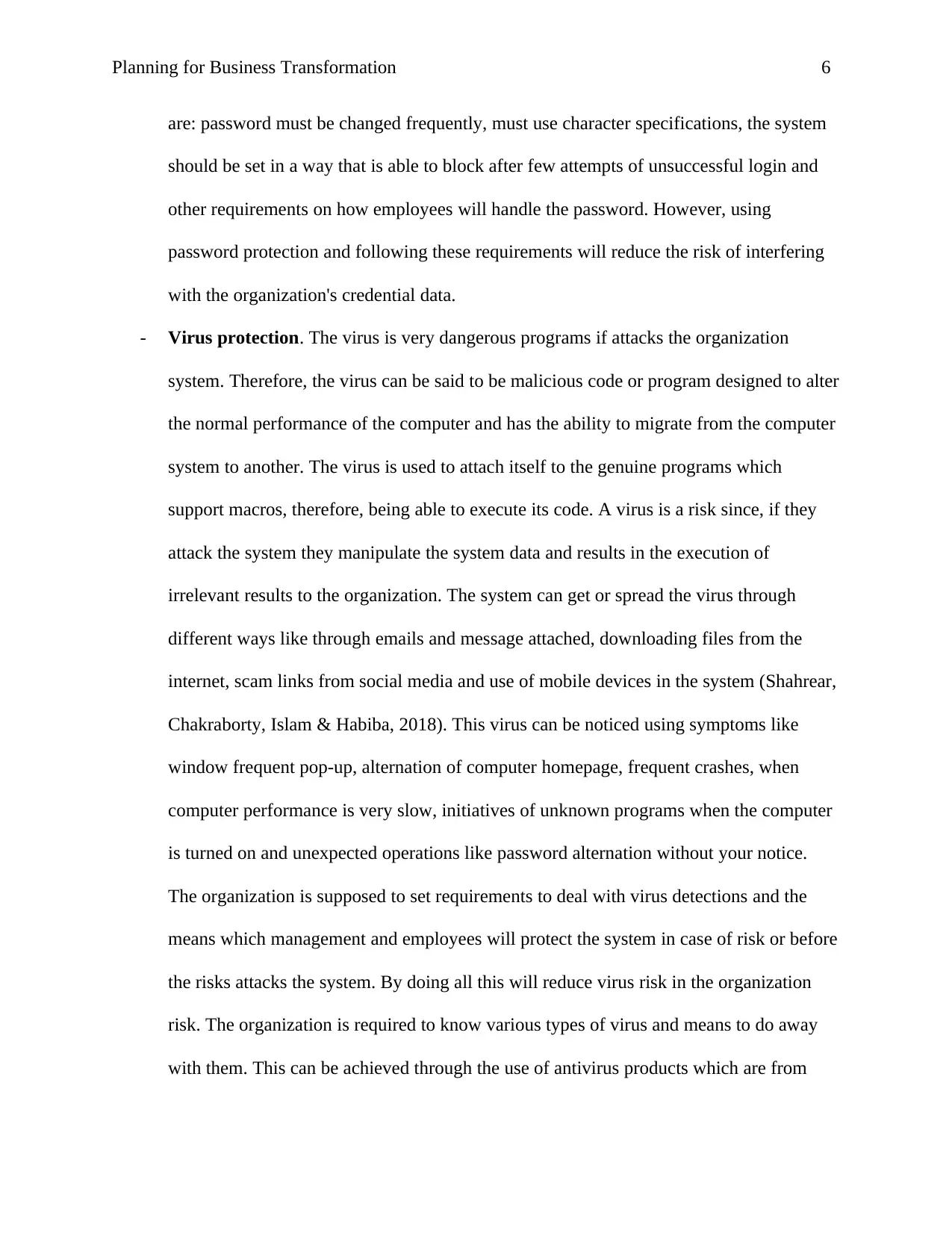
Planning for Business Transformation 6
are: password must be changed frequently, must use character specifications, the system
should be set in a way that is able to block after few attempts of unsuccessful login and
other requirements on how employees will handle the password. However, using
password protection and following these requirements will reduce the risk of interfering
with the organization's credential data.
- Virus protection. The virus is very dangerous programs if attacks the organization
system. Therefore, the virus can be said to be malicious code or program designed to alter
the normal performance of the computer and has the ability to migrate from the computer
system to another. The virus is used to attach itself to the genuine programs which
support macros, therefore, being able to execute its code. A virus is a risk since, if they
attack the system they manipulate the system data and results in the execution of
irrelevant results to the organization. The system can get or spread the virus through
different ways like through emails and message attached, downloading files from the
internet, scam links from social media and use of mobile devices in the system (Shahrear,
Chakraborty, Islam & Habiba, 2018). This virus can be noticed using symptoms like
window frequent pop-up, alternation of computer homepage, frequent crashes, when
computer performance is very slow, initiatives of unknown programs when the computer
is turned on and unexpected operations like password alternation without your notice.
The organization is supposed to set requirements to deal with virus detections and the
means which management and employees will protect the system in case of risk or before
the risks attacks the system. By doing all this will reduce virus risk in the organization
risk. The organization is required to know various types of virus and means to do away
with them. This can be achieved through the use of antivirus products which are from
are: password must be changed frequently, must use character specifications, the system
should be set in a way that is able to block after few attempts of unsuccessful login and
other requirements on how employees will handle the password. However, using
password protection and following these requirements will reduce the risk of interfering
with the organization's credential data.
- Virus protection. The virus is very dangerous programs if attacks the organization
system. Therefore, the virus can be said to be malicious code or program designed to alter
the normal performance of the computer and has the ability to migrate from the computer
system to another. The virus is used to attach itself to the genuine programs which
support macros, therefore, being able to execute its code. A virus is a risk since, if they
attack the system they manipulate the system data and results in the execution of
irrelevant results to the organization. The system can get or spread the virus through
different ways like through emails and message attached, downloading files from the
internet, scam links from social media and use of mobile devices in the system (Shahrear,
Chakraborty, Islam & Habiba, 2018). This virus can be noticed using symptoms like
window frequent pop-up, alternation of computer homepage, frequent crashes, when
computer performance is very slow, initiatives of unknown programs when the computer
is turned on and unexpected operations like password alternation without your notice.
The organization is supposed to set requirements to deal with virus detections and the
means which management and employees will protect the system in case of risk or before
the risks attacks the system. By doing all this will reduce virus risk in the organization
risk. The organization is required to know various types of virus and means to do away
with them. This can be achieved through the use of antivirus products which are from
⊘ This is a preview!⊘
Do you want full access?
Subscribe today to unlock all pages.

Trusted by 1+ million students worldwide

Planning for Business Transformation 7
trusted source like "Norton Antivirus Basic", updating the system frequently, avoiding to
click on any advertisement pop-up appears in the window screen, is advisable to
frequently to scan the email attachments before opening and downloading them and be
aware of the sources of shared documents and programs.
External Compliance Risk
These to the external risk which is imposed on the organization from the external environment
like Government and another body of authorities in the state. Example of external risks to the
organization includes Health and Safety at Work, Privacy Act, the Employment Relations Act,
Wages Protection Act, Income Tax Act, and the Human Rights Act. These are regulation bodies
which set principles of work conditions, codes of conduct and responsibilities the organization
should play to the state. These principles and code of contract can act as the risk to the
organization in one way or the other. Employment Relations Act 2000 and Income Tax Act 1983
are discussed in details below.
- Employment Relations Act 2000. This is an external Body of Authority which is used to
formulate rules and regulations to the governor the relationship between the employer
and employee under contract. These principles in one way or the others act like risks to
the organization if they influence negative conditions of the employer offering the
contract and favor the employee. Both Employer and employees, each should be aware of
the duties and obligation to perform in the organization, therefore, avoiding any risk
which may occur after breaching the contract in one way or the other. For example, some
measures and required are set towards employers duties which the organization must
fulfill to the employees (Hebson & Rubery, 2018). These requirements are like: to pay
the work according to the Act, to ensure safety in the workplace, to offer paid leave for
trusted source like "Norton Antivirus Basic", updating the system frequently, avoiding to
click on any advertisement pop-up appears in the window screen, is advisable to
frequently to scan the email attachments before opening and downloading them and be
aware of the sources of shared documents and programs.
External Compliance Risk
These to the external risk which is imposed on the organization from the external environment
like Government and another body of authorities in the state. Example of external risks to the
organization includes Health and Safety at Work, Privacy Act, the Employment Relations Act,
Wages Protection Act, Income Tax Act, and the Human Rights Act. These are regulation bodies
which set principles of work conditions, codes of conduct and responsibilities the organization
should play to the state. These principles and code of contract can act as the risk to the
organization in one way or the other. Employment Relations Act 2000 and Income Tax Act 1983
are discussed in details below.
- Employment Relations Act 2000. This is an external Body of Authority which is used to
formulate rules and regulations to the governor the relationship between the employer
and employee under contract. These principles in one way or the others act like risks to
the organization if they influence negative conditions of the employer offering the
contract and favor the employee. Both Employer and employees, each should be aware of
the duties and obligation to perform in the organization, therefore, avoiding any risk
which may occur after breaching the contract in one way or the other. For example, some
measures and required are set towards employers duties which the organization must
fulfill to the employees (Hebson & Rubery, 2018). These requirements are like: to pay
the work according to the Act, to ensure safety in the workplace, to offer paid leave for
Paraphrase This Document
Need a fresh take? Get an instant paraphrase of this document with our AI Paraphraser

Planning for Business Transformation 8
the employees, to offer free and fair employee treatment without any discrimination, to
have an employment agreement which is in written format to avoid misunderstanding of
the contract. Other duties belong to the employees under contract: is required to work
according to the signed agreement, to obey organization instructions, to be available in
case of overtime if overtime clause was available in the contract, disciplinary action to be
allowed for any misconduct performed in the organization and to be ready to show
fidelity. If the organization maintains and respects the signed requirement under the
Employment Relation Act, these compliances will reduce the risks in the organization
and results to high performance in the market and enjoy strong competitive advantages
(Timming & Mansell, 2018).
- Income Tax Act 1983. This Act of Income Tax affects the income of individuals and
organizations in New Zealand state. These tax are imposed on the earned income by the
organization form its activities, therefore, affecting the business revenue. The higher the
income generated the high the tax imposed which one way becomes a discouragement to
the organization performance (Cascio & Lewis, 2018). However, if the business fails to
comply with these rules of income tax, the Authority of the states takes a heavy penalty
to the organization thus becoming negatively affected, therefore, reacting as a risk. The
organization must ensure to have all required documents which will help to return tax in a
simple and clear way. All stakeholders of the organization should be aware of the income
tax regulations and have enough knowledge about how that calculation is done to avoid
inconvenience and enhances transparency in the organization.
the employees, to offer free and fair employee treatment without any discrimination, to
have an employment agreement which is in written format to avoid misunderstanding of
the contract. Other duties belong to the employees under contract: is required to work
according to the signed agreement, to obey organization instructions, to be available in
case of overtime if overtime clause was available in the contract, disciplinary action to be
allowed for any misconduct performed in the organization and to be ready to show
fidelity. If the organization maintains and respects the signed requirement under the
Employment Relation Act, these compliances will reduce the risks in the organization
and results to high performance in the market and enjoy strong competitive advantages
(Timming & Mansell, 2018).
- Income Tax Act 1983. This Act of Income Tax affects the income of individuals and
organizations in New Zealand state. These tax are imposed on the earned income by the
organization form its activities, therefore, affecting the business revenue. The higher the
income generated the high the tax imposed which one way becomes a discouragement to
the organization performance (Cascio & Lewis, 2018). However, if the business fails to
comply with these rules of income tax, the Authority of the states takes a heavy penalty
to the organization thus becoming negatively affected, therefore, reacting as a risk. The
organization must ensure to have all required documents which will help to return tax in a
simple and clear way. All stakeholders of the organization should be aware of the income
tax regulations and have enough knowledge about how that calculation is done to avoid
inconvenience and enhances transparency in the organization.

Planning for Business Transformation 9
Internal Communication for Internal Compliance
Communication is an essential factor when dealing with compliance requirement in the
organization. This helps the organization through respective stakeholder and managers to adhere
to the requirement as stated by each compliance risk. Communication will facilitate smooth flow
of communication and adequate knowledge on how to react and handle when risk appears in the
organization (Lefcourt, 2018).
Virus Protection will be selected compliance risk in the organization in generating
communication among managers. Communication among manager will be discussed using the
following subtitle below:
Compliance Requirements
Several requirements are required to implement in the organization systems to protect the virus
affecting the systems. This is dangerous if organization through manager’s failures to take action
on the virus infection since when occurs they lower and damages the performance of the
organization through altering document intended function and purpose (Liang, Cao & Qi, 2018).
The following are requirements to put in place in dealing with Virus Protection.
- Installing antivirus programs. These programs are very useful if are sourced from the
trusted source. This will give assurance of total protection against the virus attacking the
system. For example of strong antivirus is Norton Security Scan which is successful
tasted in several programs.
- Ensuring frequent update of the system. This helps to keep the system programs up to
date and having fresh renewed to have the best performance. This will help to remove
any malicious subprograms defects which might come after the program expired.
Internal Communication for Internal Compliance
Communication is an essential factor when dealing with compliance requirement in the
organization. This helps the organization through respective stakeholder and managers to adhere
to the requirement as stated by each compliance risk. Communication will facilitate smooth flow
of communication and adequate knowledge on how to react and handle when risk appears in the
organization (Lefcourt, 2018).
Virus Protection will be selected compliance risk in the organization in generating
communication among managers. Communication among manager will be discussed using the
following subtitle below:
Compliance Requirements
Several requirements are required to implement in the organization systems to protect the virus
affecting the systems. This is dangerous if organization through manager’s failures to take action
on the virus infection since when occurs they lower and damages the performance of the
organization through altering document intended function and purpose (Liang, Cao & Qi, 2018).
The following are requirements to put in place in dealing with Virus Protection.
- Installing antivirus programs. These programs are very useful if are sourced from the
trusted source. This will give assurance of total protection against the virus attacking the
system. For example of strong antivirus is Norton Security Scan which is successful
tasted in several programs.
- Ensuring frequent update of the system. This helps to keep the system programs up to
date and having fresh renewed to have the best performance. This will help to remove
any malicious subprograms defects which might come after the program expired.
⊘ This is a preview!⊘
Do you want full access?
Subscribe today to unlock all pages.

Trusted by 1+ million students worldwide
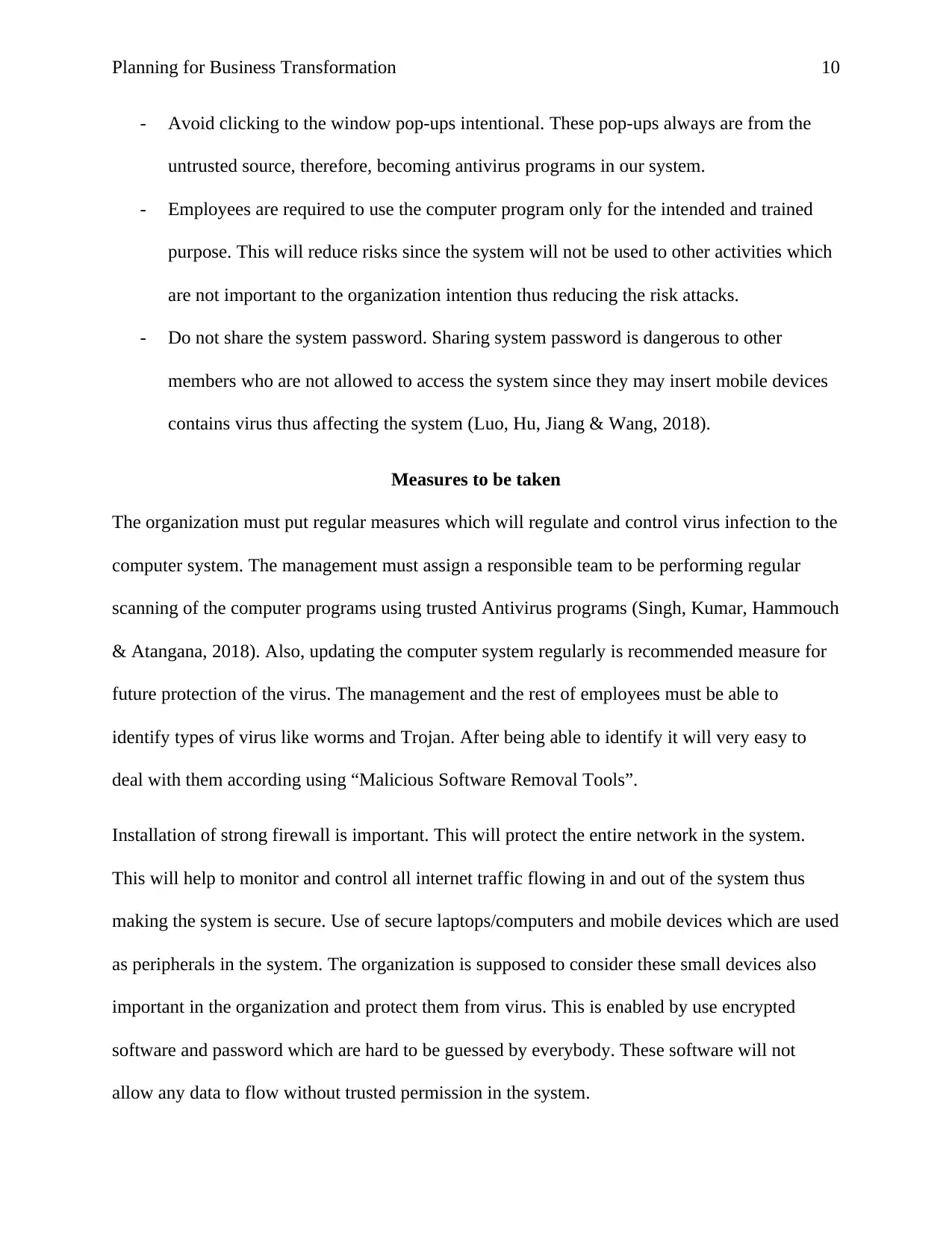
Planning for Business Transformation 10
- Avoid clicking to the window pop-ups intentional. These pop-ups always are from the
untrusted source, therefore, becoming antivirus programs in our system.
- Employees are required to use the computer program only for the intended and trained
purpose. This will reduce risks since the system will not be used to other activities which
are not important to the organization intention thus reducing the risk attacks.
- Do not share the system password. Sharing system password is dangerous to other
members who are not allowed to access the system since they may insert mobile devices
contains virus thus affecting the system (Luo, Hu, Jiang & Wang, 2018).
Measures to be taken
The organization must put regular measures which will regulate and control virus infection to the
computer system. The management must assign a responsible team to be performing regular
scanning of the computer programs using trusted Antivirus programs (Singh, Kumar, Hammouch
& Atangana, 2018). Also, updating the computer system regularly is recommended measure for
future protection of the virus. The management and the rest of employees must be able to
identify types of virus like worms and Trojan. After being able to identify it will very easy to
deal with them according using “Malicious Software Removal Tools”.
Installation of strong firewall is important. This will protect the entire network in the system.
This will help to monitor and control all internet traffic flowing in and out of the system thus
making the system is secure. Use of secure laptops/computers and mobile devices which are used
as peripherals in the system. The organization is supposed to consider these small devices also
important in the organization and protect them from virus. This is enabled by use encrypted
software and password which are hard to be guessed by everybody. These software will not
allow any data to flow without trusted permission in the system.
- Avoid clicking to the window pop-ups intentional. These pop-ups always are from the
untrusted source, therefore, becoming antivirus programs in our system.
- Employees are required to use the computer program only for the intended and trained
purpose. This will reduce risks since the system will not be used to other activities which
are not important to the organization intention thus reducing the risk attacks.
- Do not share the system password. Sharing system password is dangerous to other
members who are not allowed to access the system since they may insert mobile devices
contains virus thus affecting the system (Luo, Hu, Jiang & Wang, 2018).
Measures to be taken
The organization must put regular measures which will regulate and control virus infection to the
computer system. The management must assign a responsible team to be performing regular
scanning of the computer programs using trusted Antivirus programs (Singh, Kumar, Hammouch
& Atangana, 2018). Also, updating the computer system regularly is recommended measure for
future protection of the virus. The management and the rest of employees must be able to
identify types of virus like worms and Trojan. After being able to identify it will very easy to
deal with them according using “Malicious Software Removal Tools”.
Installation of strong firewall is important. This will protect the entire network in the system.
This will help to monitor and control all internet traffic flowing in and out of the system thus
making the system is secure. Use of secure laptops/computers and mobile devices which are used
as peripherals in the system. The organization is supposed to consider these small devices also
important in the organization and protect them from virus. This is enabled by use encrypted
software and password which are hard to be guessed by everybody. These software will not
allow any data to flow without trusted permission in the system.
Paraphrase This Document
Need a fresh take? Get an instant paraphrase of this document with our AI Paraphraser
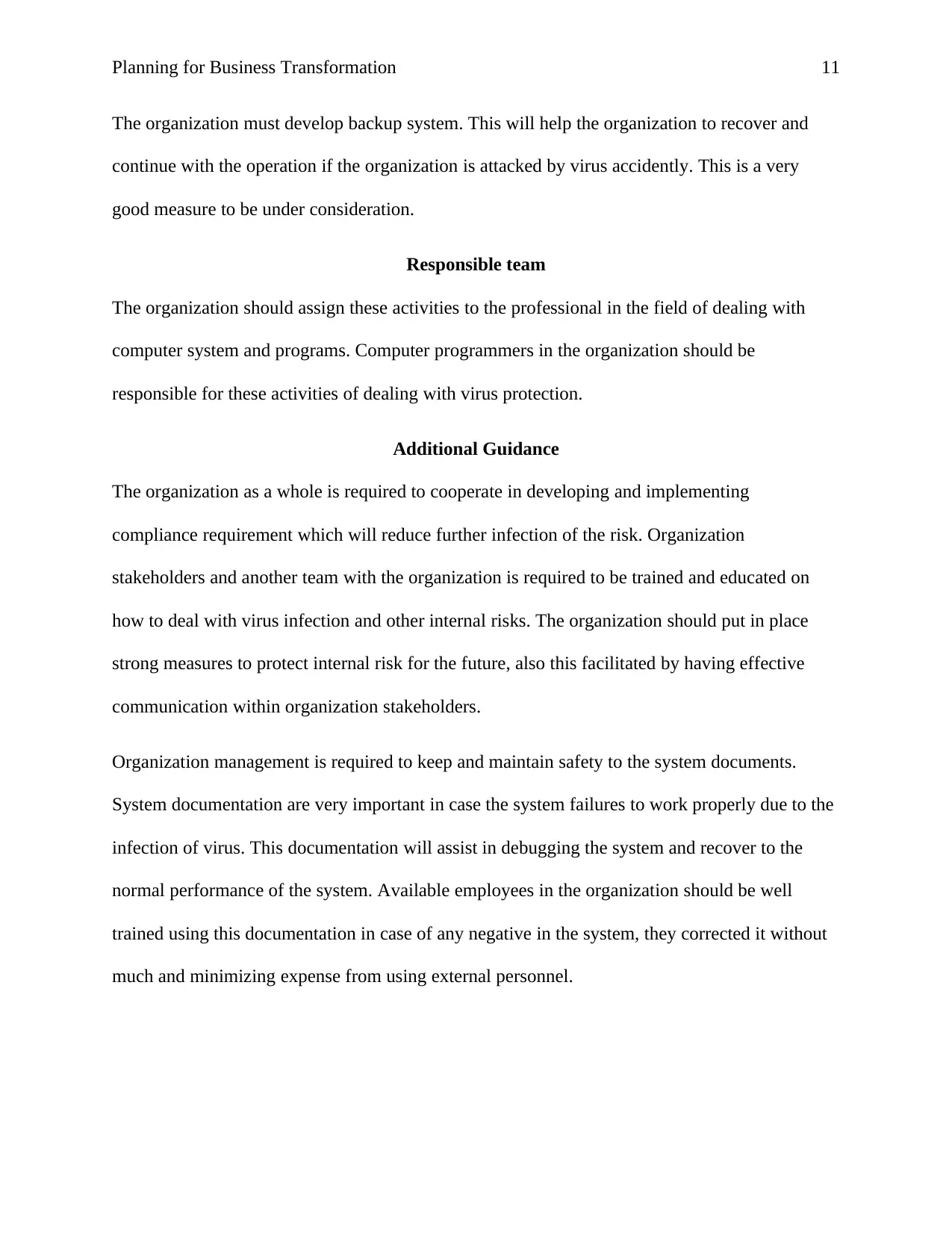
Planning for Business Transformation 11
The organization must develop backup system. This will help the organization to recover and
continue with the operation if the organization is attacked by virus accidently. This is a very
good measure to be under consideration.
Responsible team
The organization should assign these activities to the professional in the field of dealing with
computer system and programs. Computer programmers in the organization should be
responsible for these activities of dealing with virus protection.
Additional Guidance
The organization as a whole is required to cooperate in developing and implementing
compliance requirement which will reduce further infection of the risk. Organization
stakeholders and another team with the organization is required to be trained and educated on
how to deal with virus infection and other internal risks. The organization should put in place
strong measures to protect internal risk for the future, also this facilitated by having effective
communication within organization stakeholders.
Organization management is required to keep and maintain safety to the system documents.
System documentation are very important in case the system failures to work properly due to the
infection of virus. This documentation will assist in debugging the system and recover to the
normal performance of the system. Available employees in the organization should be well
trained using this documentation in case of any negative in the system, they corrected it without
much and minimizing expense from using external personnel.
The organization must develop backup system. This will help the organization to recover and
continue with the operation if the organization is attacked by virus accidently. This is a very
good measure to be under consideration.
Responsible team
The organization should assign these activities to the professional in the field of dealing with
computer system and programs. Computer programmers in the organization should be
responsible for these activities of dealing with virus protection.
Additional Guidance
The organization as a whole is required to cooperate in developing and implementing
compliance requirement which will reduce further infection of the risk. Organization
stakeholders and another team with the organization is required to be trained and educated on
how to deal with virus infection and other internal risks. The organization should put in place
strong measures to protect internal risk for the future, also this facilitated by having effective
communication within organization stakeholders.
Organization management is required to keep and maintain safety to the system documents.
System documentation are very important in case the system failures to work properly due to the
infection of virus. This documentation will assist in debugging the system and recover to the
normal performance of the system. Available employees in the organization should be well
trained using this documentation in case of any negative in the system, they corrected it without
much and minimizing expense from using external personnel.

Planning for Business Transformation 12
Conclusion
In summary, this document has alighted and discussed several internal and external compliance
requirement in the organization. Password protection and virus protection have been discussed
including the requirements and measures to put in place in protecting them from influencing the
organization negatively. Password and virus protection was discussed as an internal risk
compliance requirement. Income Tax Act 1993 and the Employment Relations Act 2000, were
discussed as external risk including their compliance requirement to the organization.
Conclusion
In summary, this document has alighted and discussed several internal and external compliance
requirement in the organization. Password protection and virus protection have been discussed
including the requirements and measures to put in place in protecting them from influencing the
organization negatively. Password and virus protection was discussed as an internal risk
compliance requirement. Income Tax Act 1993 and the Employment Relations Act 2000, were
discussed as external risk including their compliance requirement to the organization.
⊘ This is a preview!⊘
Do you want full access?
Subscribe today to unlock all pages.

Trusted by 1+ million students worldwide
1 out of 14
Related Documents
Your All-in-One AI-Powered Toolkit for Academic Success.
+13062052269
info@desklib.com
Available 24*7 on WhatsApp / Email
![[object Object]](/_next/static/media/star-bottom.7253800d.svg)
Unlock your academic potential
Copyright © 2020–2025 A2Z Services. All Rights Reserved. Developed and managed by ZUCOL.




